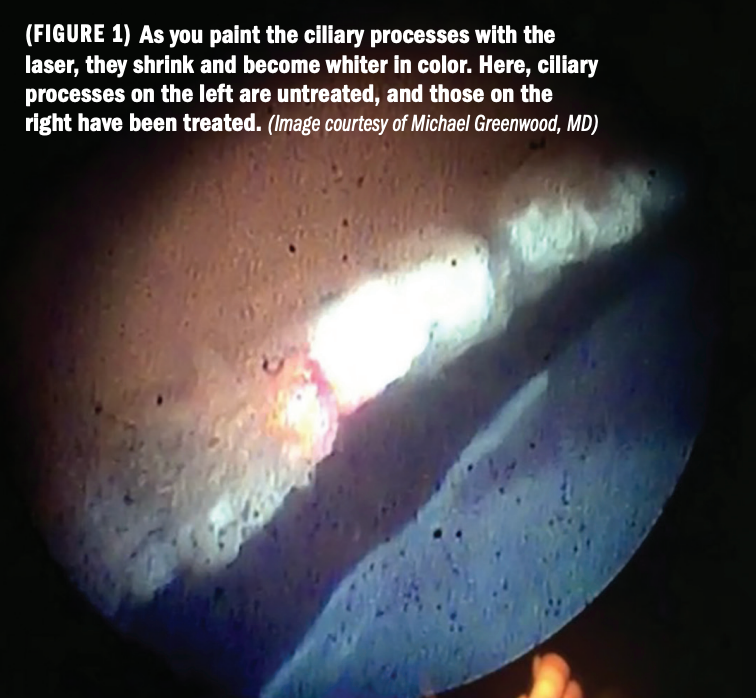Publication
Article
Digital Edition
Advantages of incorporating ECP into the surgeon’s armamentarium
Author(s):
Short learning curve, significant clinical advantages make this a comfortable addition.


Special to Ophthalmology Times®
A wealth of options exists for minimally invasive glaucoma surgery (MIGS) to reduce IOP by improving the aqueous outflow through the trabecular meshwork.
Endoscopic cyclophotocoagulation (ECP) has a different mechanism of action that lowers IOP by reducing the production of aqueous in the eye.
That makes it especially useful in combination with cataract surgery and other complementary MIGS procedures.
Related: Drainage device offers IOP lowering capabilities at 1 year
ECP also has a short learning curve, so once you know the advantages and get a few surgical tips, you will be ready to incorporate ECP into your armamentarium.
Advantages of ECP
I use ECP to treat a wide range of patients with moderate to severe primary open-angle glaucoma, particularly if they have a heavy medication burden.
It fits nicely into my practice for patients with moderate to severe glaucoma or a heavy medication burden. Here are some standout advantages of ECP:
ECP inflow reduction combines well with drainage MIGS. ECP’s unique mechanism of action makes it great to use in combination with other MIGS.
It is the only MIGS procedure that lowers IOP by controlling aqueous production, so combining it with other outflow-targeted procedures helps control the flow of aqueous in both directions.
When I am performing cataract surgery plus a MIGS trabecular meshwork procedure such as Hydrus (Ivantis), iStent (Glaukos), Kahook Dual Blade (KDB) New World Medical), OMNI (Sight Sciences) and others, I can add ECP as well.
Related: Phaco power modulation boosts safety, efficacy in cataract surgery
My colleagues published a study comparing cataract surgery with iStent implantation alone or with ECP, and they found that 12 months later, IOP was more than 2 mm HG lower when they added ECP.1
ECP can be used inside or outside of cataract surgery. One of the beautiful things about performing ECP is its versatility.
It is a straightforward addition to a cataract procedure with MIGS, adding only a little bit more time for a worthwhile reduction in IOP and/or medications.
I also use ECP for pseudophakic patients who need better IOP control and welcome a reduction in medications. In pseudophakic cases, I typically choose KDB or OMNI along with ECP.
ECP has a very short learning curve. ECP is easy for surgeons to perform, with a skill set very similar to capsulorhexis.
You fill the eye with viscoelastic, put the instrument inside the eye, and look at a separate monitor as you use the laser to perform the procedure, which takes just a short time.
Related: Study examines pairing phacoemulsification, implantation of microbypass stents
It is titratable, so you can treat a lot or a little, depending on your comfort level as you get accustomed to it. Compared to other MIGS procedures, ECP targets a larger area.
ECP step by step
To start doing ECP, you need to make a few purchases. First, there is the device itself (Endo Optiks E2). The probes are reusable but must be replaced eventually.
To watch what you are doing, you also need a standalone monitor, which you may already have. I have found that the start-up costs are quickly recovered through reimbursements for ECP.
The ECP procedure will be familiar to most surgeons.
I will walk you through the technique:
> To begin, fill the anterior chamber with viscoelastic. To ensure adequate visualization of the ciliary processes, make sure to get enough space between the iris and the intraocular lens by putting viscoelastic under the iris to make it bombe forward. ECP can treat approximately 200 degrees through a single incision, so make sure you plan for that.
> Next, insert the device into the eye, being careful not to bump into any intraocular structures. Getting good focus and adequate lighting on the ciliary processes requires the help of an assistant. It must be bright enough to see clearly, but not so bright that it is hard to distinguish where your aiming beam is located.
> Gently move the laser to the treatment area. Keeping about 4 to 6 ciliary processes in view will ensure you are at the appropriate distance to deliver the desired power—not too close (too high powered) or too far (ineffective power and greater likelihood that you could hit something other than the ciliary processes).
Related: Teleretinal screening fails to do double duty for detecting glaucoma, cataracts
> Begin applying the treatment by gently painting the ciliary processes, moving in 1 direction. At the end point, gently go in the other direction. Repeat the process on the other side.
> As you go, watch how the treatment is working. When ECP is effective, the ciliary processes get whiter in color and shrink (Figure 1). If your probe placement is correct, but you are not seeing an effect, you can gently increase the power of the laser. If you apply too much energy, the processes can burst, causing a popping sound that startles the patient and can cause pain as well as some postoperative inflammation. With experience, you will soon become accustomed to doing this properly.
> Postoperative medications are a bit different for patients who have ECP. For a standard cataract, cataract+MIGS, or cataract+MIGS+ECP, my patients get an intracameral antibiotic, steroid, and nonsteroidal drug. Postoperatively, cataract patients without ECP take 1 drop of a combination antibiotic, steroid, and nonsteroidal drug once a day for a month. When we add ECP, I prescribe the same medications, but with a stronger dose up front and a slower taper: 4 drops a day for 1 week, and 2 drops a day for 3 weeks. The intracameral steroids are very helpful.
Related: Surgical decision-making in the era of MIGS
I sometimes see a little bit more inflammation on day 1 compared with patients without ECP, but at 1 week, the eye is very quiet. And patients get those extra few points of IOP control that we know can help them not only limit medications, but perhaps prevent some progression over time.
About the author
Michael Greenwood, MD
p: 605/361-3937
Greenwood is a cataract, glaucoma, cornea, and refractive surgeon at Vance Thompson Vision in Fargo, North Dakota.
--
Reference
1. Ferguson TJ, Swan R, Sudhagoni R, Berdahl JP. Microbypass stent implantation with cataract extraction and endocyclophotocoagulation versus microbypass stent with cataract extraction for glaucoma. J Cataract Refract Surg. 2017;43(3):377-382. doi:10.1016/j.jcrs.2016.12.020

Newsletter
Don’t miss out—get Ophthalmology Times updates on the latest clinical advancements and expert interviews, straight to your inbox.




